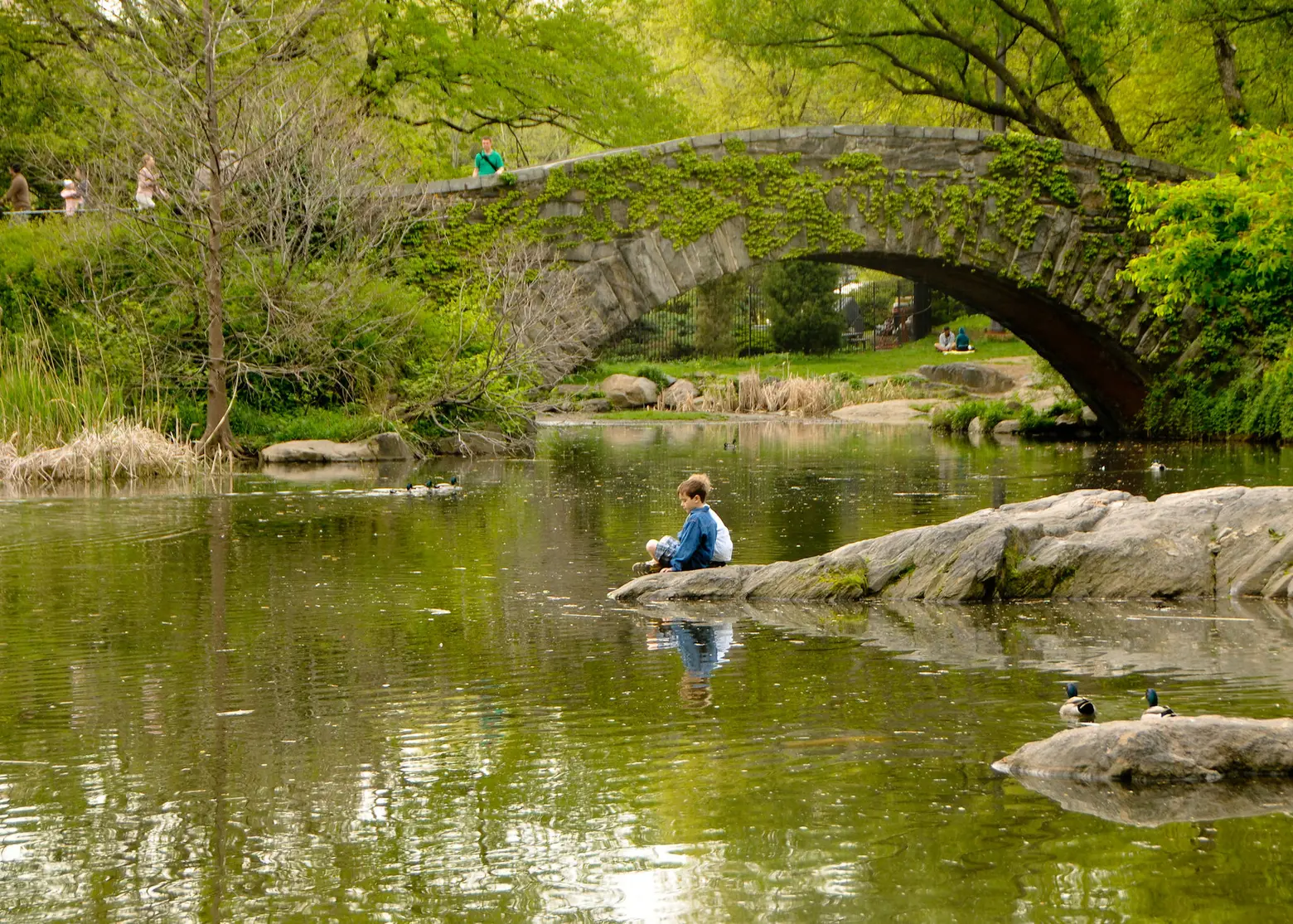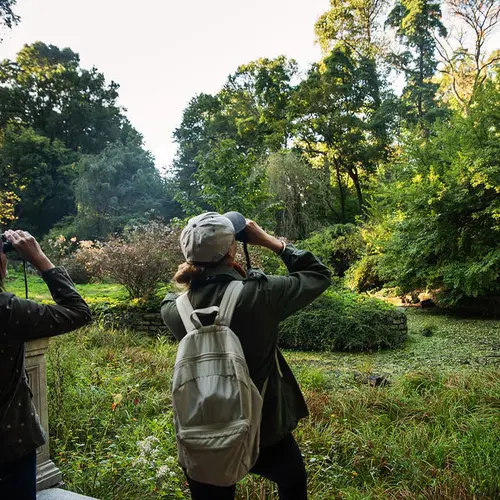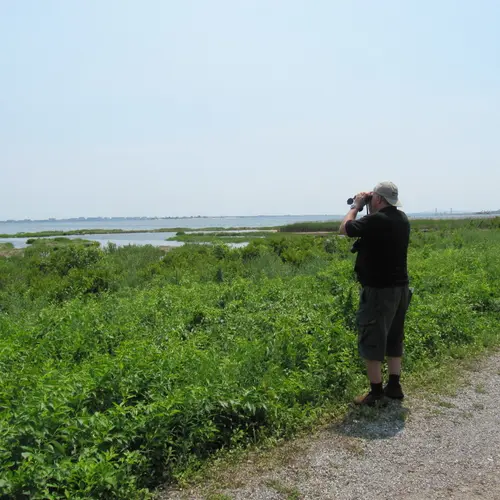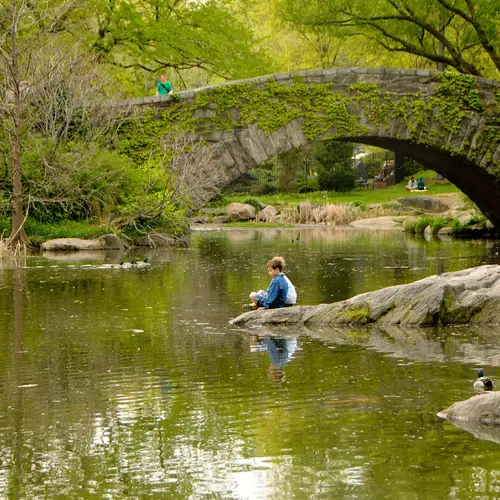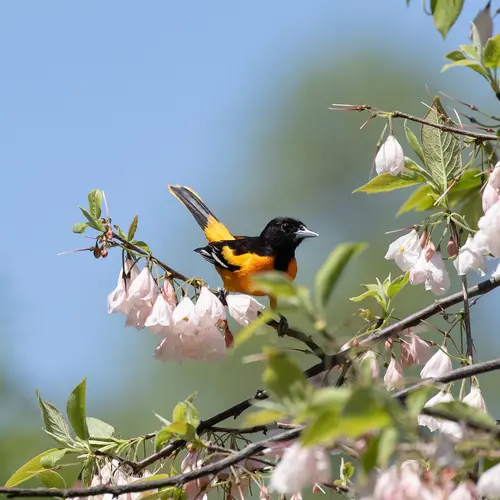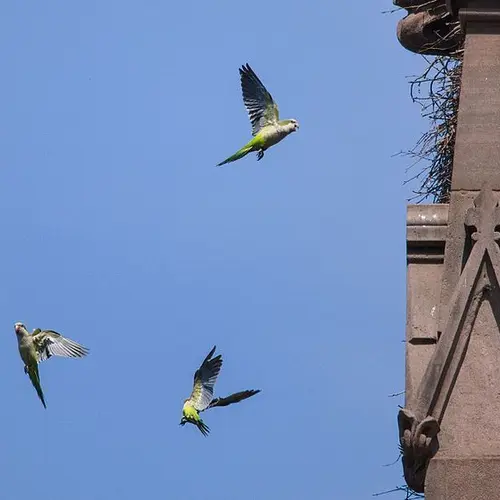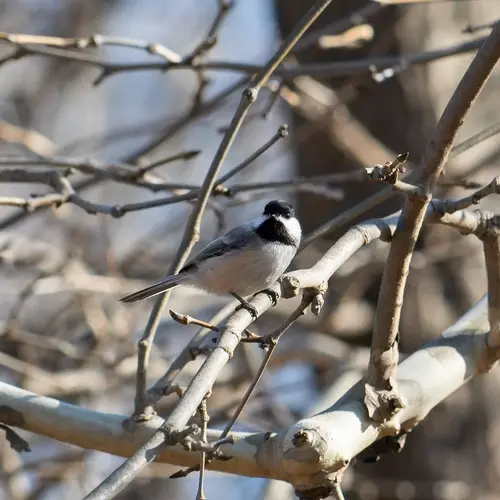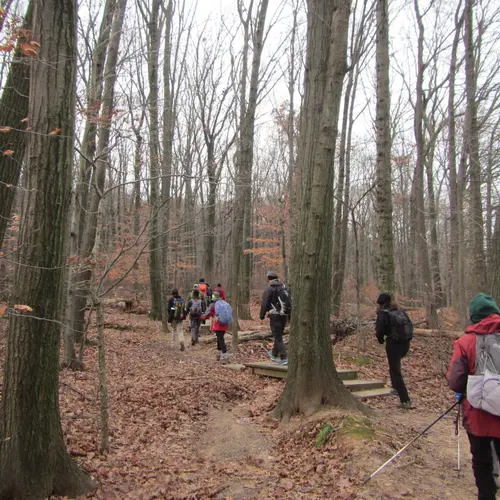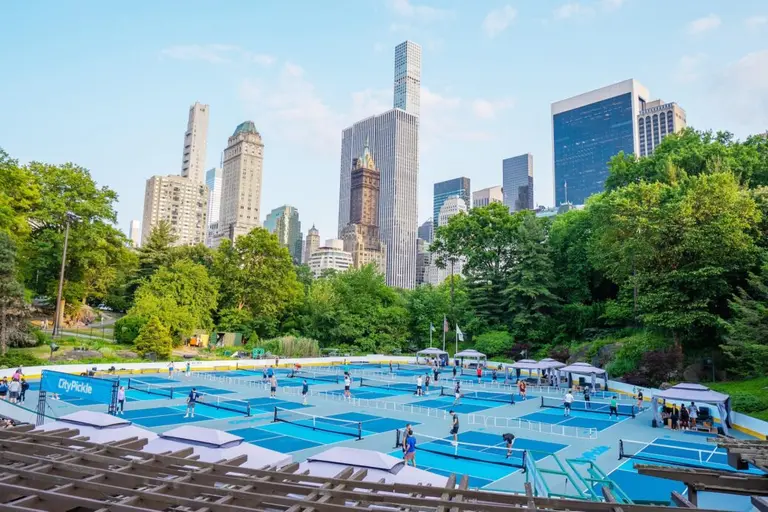New York City’s best spots for bird watching
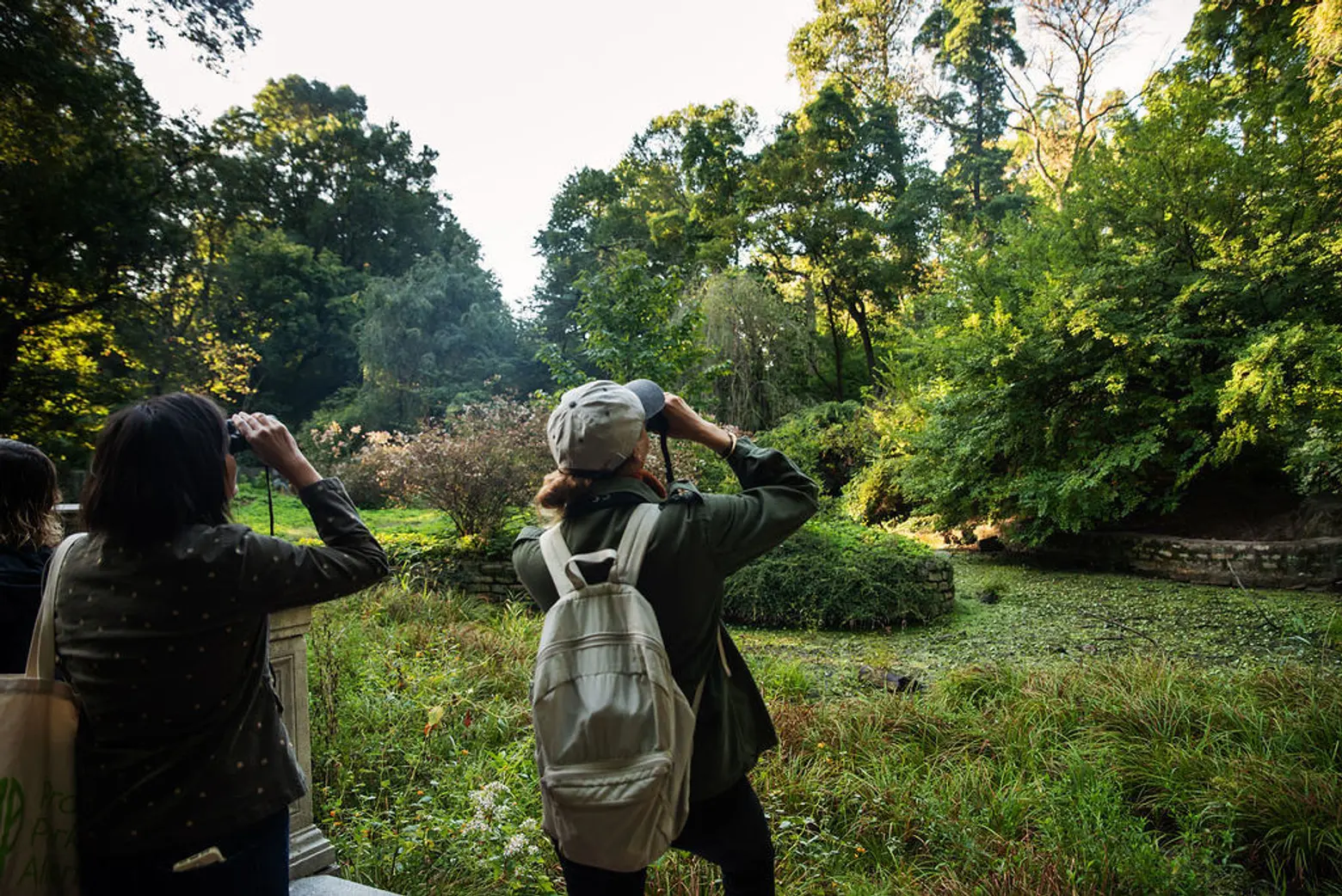
Birdwatching in Prospect Park, courtesy of the Prospect Park Alliance on Flickr
With hundreds of parks and over 500 miles of waterfront, New York City is an excellent place for bird watching. The five boroughs serve as a temporary and permanent home to over 400 species of bird, thanks to both habitat diversity and location on the Atlantic Flyway, the route birds follow during migrations. From Pelham Bay Park in the northeast Bronx down to Great Kills Park on the South Shore of Staten Island, there is no shortage of birding activities in New York. We’ve rounded up the best places to find feathered friends throughout the city, most of which are accessible via public transportation. For guided bird-watching tours and walks, check out events from NYC Parks, NYC Audubon, and the Linnaean Society of New York.
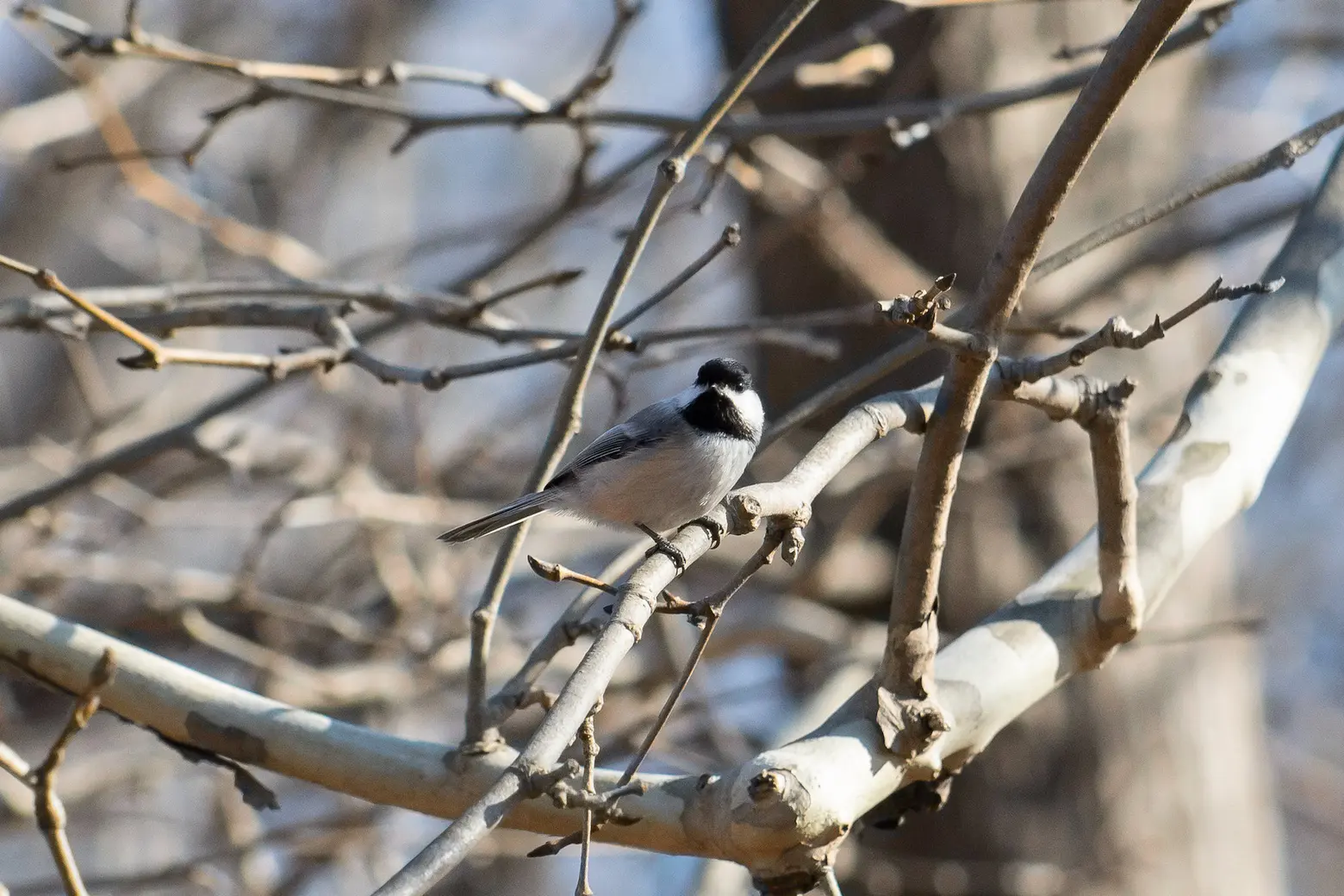
Photo of a black-capped chickadee in Pelham Bay Park by Ryan Mandelbaum on Flickr
The Bronx
Pelham Bay Park
As New York City’s largest park, Pelham Bay Park is a great place to observe and enjoy nature. The park, located in the northeast section of the borough, is made up of 2,700 acres of natural forest, woodlands, meadows, marsh, and more. Due to its diverse habitats, Pelham Bay Park serves as a major stopover site for a variety of migrant birds, with forest and scrub habitats supporting birds like the red-eyed vireo, wood thrush, gray catbird, chestnut-sided warbler, and the salt marshes supporting the marsh wren and swamp sparrow, according to the National Audubon Society.
In the winter, the park is a good place to spot owls, particularly the great horned owls. Snowy and barred owls will occasionally make an appearance too. Peregrine falcons, merlins, red-tailed hawks, and woodpeckers can be found year-round. Springtime means songbirds and shorebirds, with summer bringing seaside sparrows, clapper rail, orchard oriole, and more, as NYC Audubon notes.
Van Cortlandt Park
Stretching between both the northwest Bronx to Westchester County, Van Cortlandt Park is the third largest park in NYC. At this chunk of natural land surrounded by urban life, over 200 different species have been spotted over the years. Songbirds and raptors are drawn to its woodlands and meadows while migrating, with owls, hawks, ducks, and geese found in the colder months. Enter the park at West 242nd Street and start with the park’s John Kiernan Nature Trail, a popular 1.25-mile trail for birding. Wood ducks and mallards, red-winged blackbirds, and great egrets can be spotted at Van Cortlandt Lake. In the spring, you’ll likely find woodpeckers, warblers, wrens, and the Baltimore oriole in the 158-acre Croton Woods, NYC Parks says.
The Van Cortlandt Park Alliance and NYC Audubon are teaming up this spring to offer weekly bird walks led by an expert guide. Advance registration is required to participate in the bird walks, which are limited to 12 people per week.
New York Botanical Garden
Birders know that the best time to observe birds at the New York Botanical Garden is during the fall migration, with warblers, ruby-throated hummingbirds, tanagers, and grosbeaks arriving in the late summer months through October. But the diverse gardens and 250 acres of meadow and forest, as well as the Bronx River, make NYBG a favorite for birders all year round. NYC Audubon recommends checking out Twin Lakes because it touches multiple habitats and is home to egrets, herons, and a variety of ducks. In non-pandemic times, the NYBG offers free guided bird walks on Saturday mornings led by guide Debbie Becker.
Spuyten Duyvil Shorefront Park
Located where the Hudson and Harlem Rivers meet, the Spuyten Duyvil Shorefront Park is a small waterfront public park that attracts woodpeckers, vireos, swallows, thrushes, and warblers. Egrets, ring-necked pheasants, mallards, and spotted and solitary sandpipers, have also been seen at the park.
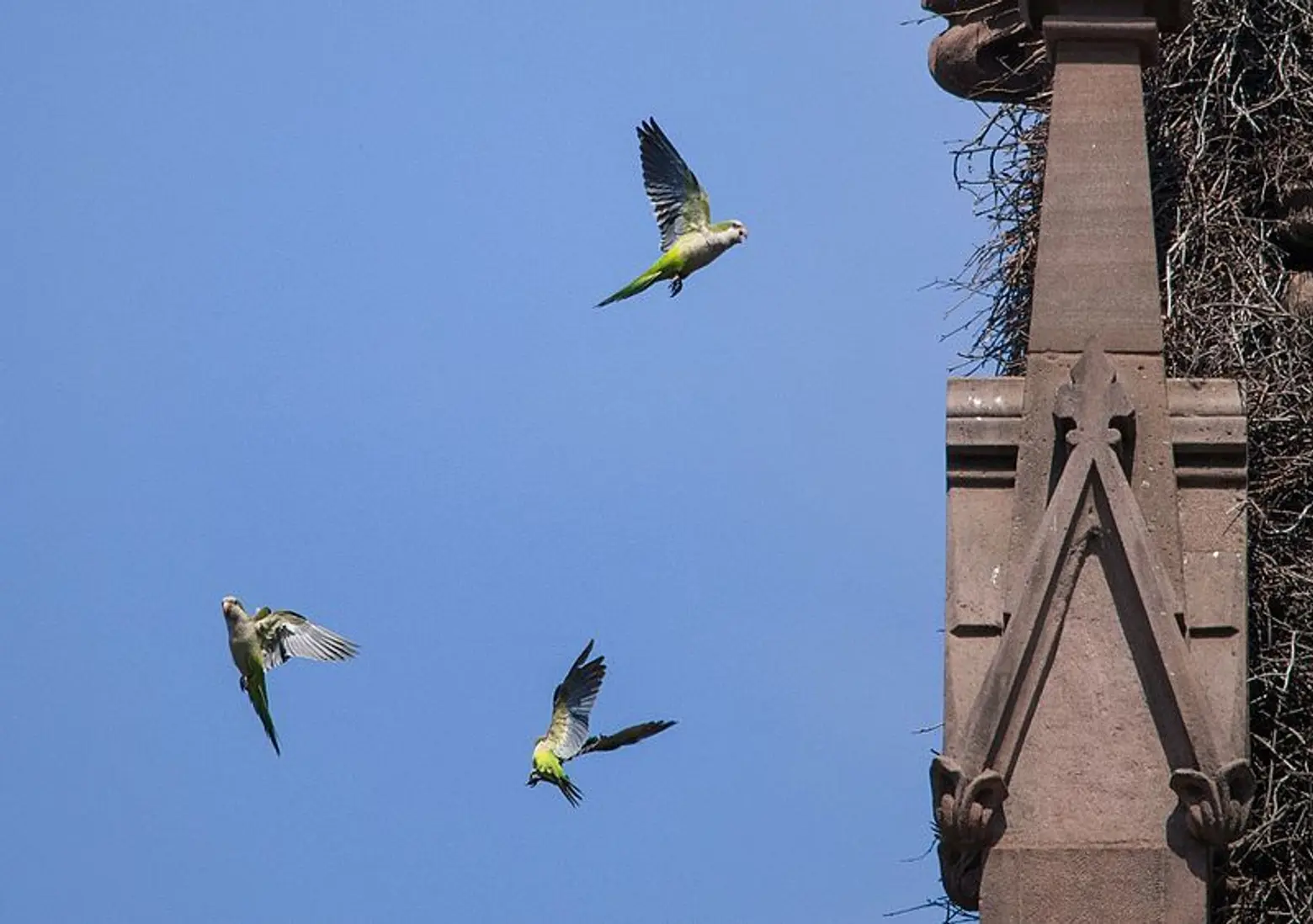
Photo of Monk parakeet flying near their nest in the entrance gate of Green-Wood Cemetery by Rhododendrites on Wikimedia
Brooklyn
Prospect Park + Brooklyn Botanic Garden
It’s no surprise that Prospect Park, measuring over 580 acres and located on the Atlantic Flyway, makes the list. Although it’s surrounded by the bustling urban neighborhoods of Brooklyn, the park is considered a vital migratory stopover for land birds. According to the National Audubon Society, which designated the park as one of New York’s Important Bird Areas (IBAs), more than 250 species have been recorded in the park, many of which can be seen in one day. Key birding spots include Prospect Park Lake, The Ravine, and Lookout Hill, where bird watchers have spotted “five species of vireo, vesper, and white-crowned sparrow, rose-breasted grosbeak, indigo bunting, bobolink, orchard oriole, and Baltimore oriole,” according to NYC Audubon. The park is also home to its own Audubon Center, which offers free nature programming for New Yorkers of all ages.
Just to the east of the park is the Brooklyn Botanic Garden, 52 acres of gardens and green space, which are ideal for birds seeking food and shelter. The Japanese Hill and Pond Garden attract pied-billed grebe, wood duck, American wigeon, and northern shoveler. When BBG was closed last spring because of the coronavirus, birds like Canadian geese and red-tailed hawks, thrived without many people around.
Green-Wood Cemetry
With over 470 acres, fascinating history, and unique architectural elements, Green-Wood Cemetery is the perfect place for a stroll. Add in the over 185 species of migrating birds that stop at the site and you also have a peaceful birding experience. In the winter, expect waterfowls, sparrows, woodpeckers, ruby-throated hummingbirds, over 20 species of wood-warblers in the spring, and in the summer, unique nesting monk parakeet and eastern kingbirds. Lots of old trees, four ponds, and monuments are the favorite spots of a variety of species. Birding expert Rob Jett leads walking tours at the cemetery on early Sunday mornings. Tickets are $20 or $15 for members.
Marine Park
While it may be lesser known than other parks in the borough, Marine Park Preserve is a must-visit for nature lovers. The largest park in Brooklyn, the preserve measures 530 acres and is made up of salt marshes and grassland that surround the freshwater stream of Gerritsen Creek, part of Jamaica Bay. According to NYC Audubon, this ecosystem, where saltwater meets freshwater, attracts roughly 257 bird species, 50 butterfly species, and 100 types of fish. Most commonly spotted include myrtle warblers, red-breasted mergansers grasshopper sparrows, and ring-necked pheasants. Ospreys can also be found feasting on fish or atop nesting platforms.
Shirley Chisholm State Park
As one of Brooklyn’s latest parks, Shirley Chisholm State Park offers longtime birders a new experience. The 407-acre park, which opened in 2019, sits on Jamaica Bay and provides many recreational activities, including hiking, biking, and fishing. Despite opening to the public just two years ago, over 150 species have been recorded by the online database eBird. You can expect to see hunters like peregrine falcons and American kestrels taking advantage of the park’s high elevation all year, with “foraging wading birds, terns, and shorebirds, and diving and dabbling ducks during the winter months,” according to NYC Audubon.
Manhattan
Central Park
One of the world’s most popular public parks is also a popular spot for bird watching. While you may have seen the beautiful Mandarin duck in 2018 and Flaco, the Eurasian eagle-owl that escaped from the zoo, did you know Central Park is home to over 200 species of birds? NYC Parks recommends checking out the wooded Ramble in the center of the park and the forested North Woods for observing songbirds and owls, with excellent views of hawks from Belvedere Castle.
Inwood Hill Park
Inwood Hill Park, Manhattan’s last remaining natural forest and sole salt marsh, has a number of steep hills and rock formations. Located on the Hudson River at the very northern end of the borough, bird enthusiasts have reported sightings of songbirds, screech and barred owls, and kingfishers. Must-see places inside Inwood Hill Park include Muscota Marsh, a salt and freshwater marsh, and the Dyckman Fields, where waterbirds, raptors, and bald eagles are known to visit.
Governors Island
Governors Island, a 172-acre island in the middle of the harbor and south of Manhattan, serves as a pit stop location for many migratory birds. The latest count from eBird says 217 species have been spotted on the island. NYC Audubon operates a nature center during the island’s six-month season, offering family-friendly bird walks and nature-themed activities.
Swindler Cove Park
Located in Washington Heights’ Sherman Creek Park, Swindler Cove Park has been transformed in recent years from a former illegal dumping site into a public park. Following a $10 million restoration that opened in 2003, the park now boasts native plants, a saltwater marsh, and a freshwater pond. These features attract species like northern flicker, eastern kingbird, cedar waxwing, yellow warbler, red-winged blackbird, and Baltimore oriole during the warmer months and American goldfinches seen throughout the year.
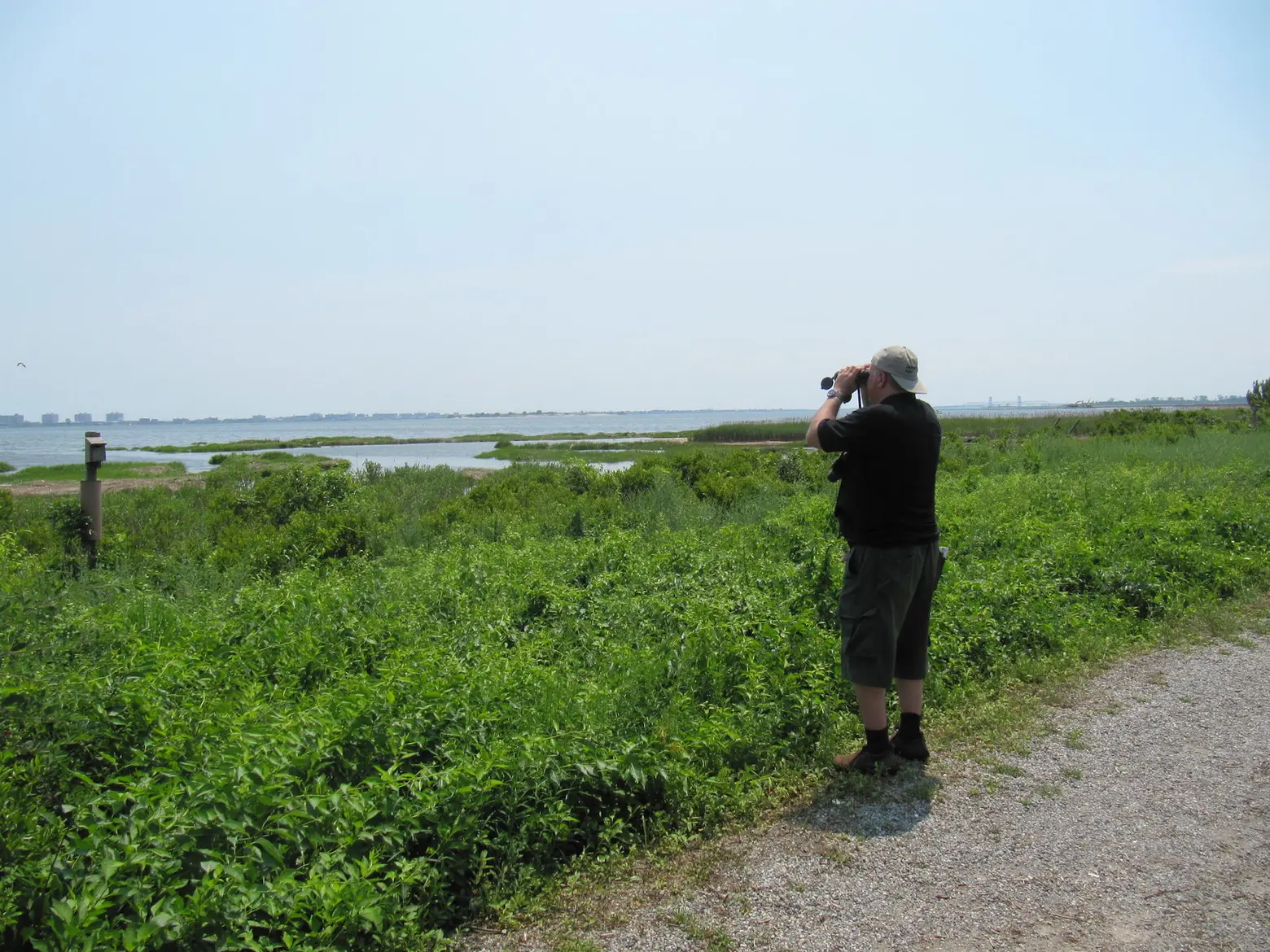
Photo of the Jamaica Bay Wildlife Refuge by Jeff on Flickr
Queens
Jamaica Bay Wildlife Refuge
With over 12,600 acres of water, salt marshes, freshwater, uplands, open bay, and island, the Jamaica Bay Wildlife is home to one of the largest bird habitats in the northeast, according to the National Park Service, which runs the site as part of Gateway National Recreation Area. This wetland habitat in Queens supports a diverse group of shorebirds, including black-bellied plovers, red knots, and about three dozen other species. Along the beaches, birders can expect to find piping plovers, laughing gulls, and common terns. About 70 species nest frequently at the Refuge, including great egret, snowy egret, yellow-crowned night-heron, glossy ibis, tricolored heron, and more. Overall, over 330 species of birds have been sighted here.
Forest Park
Located in central Queens, Forest Park is home to the borough’s largest continuous oak forest as well as a “knob and kettle” natural terrain. As NYC Audubon notes, this type of landscape creates cavities that fill with fresh water, luring migratory birds. According to eBird, 200 species, with 36 warbler species alone, have been spotted at hotspots across the park. Other species to be on the lookout for include red-tailed hawks, mallards, American kestrels, and ruby-throated hummingbirds. NYC Parks suggests checking out the park’s Strack Pond to see the many warblers during spring migration.
The Rockaways
On the southern shore of the borough, the Rockaway Peninsula is not only a beach lover’s paradise but a bird lover’s too. Birders can walk along contiguous Jacob Riis Park, Fort Tilden, and Breezy Point and observe hawks, songbirds, and piping plovers, a threatened species that breeds on beaches along the Atlantic. The plovers have nests along the beach that are monitored by the Parks’ Wildlife Unit.
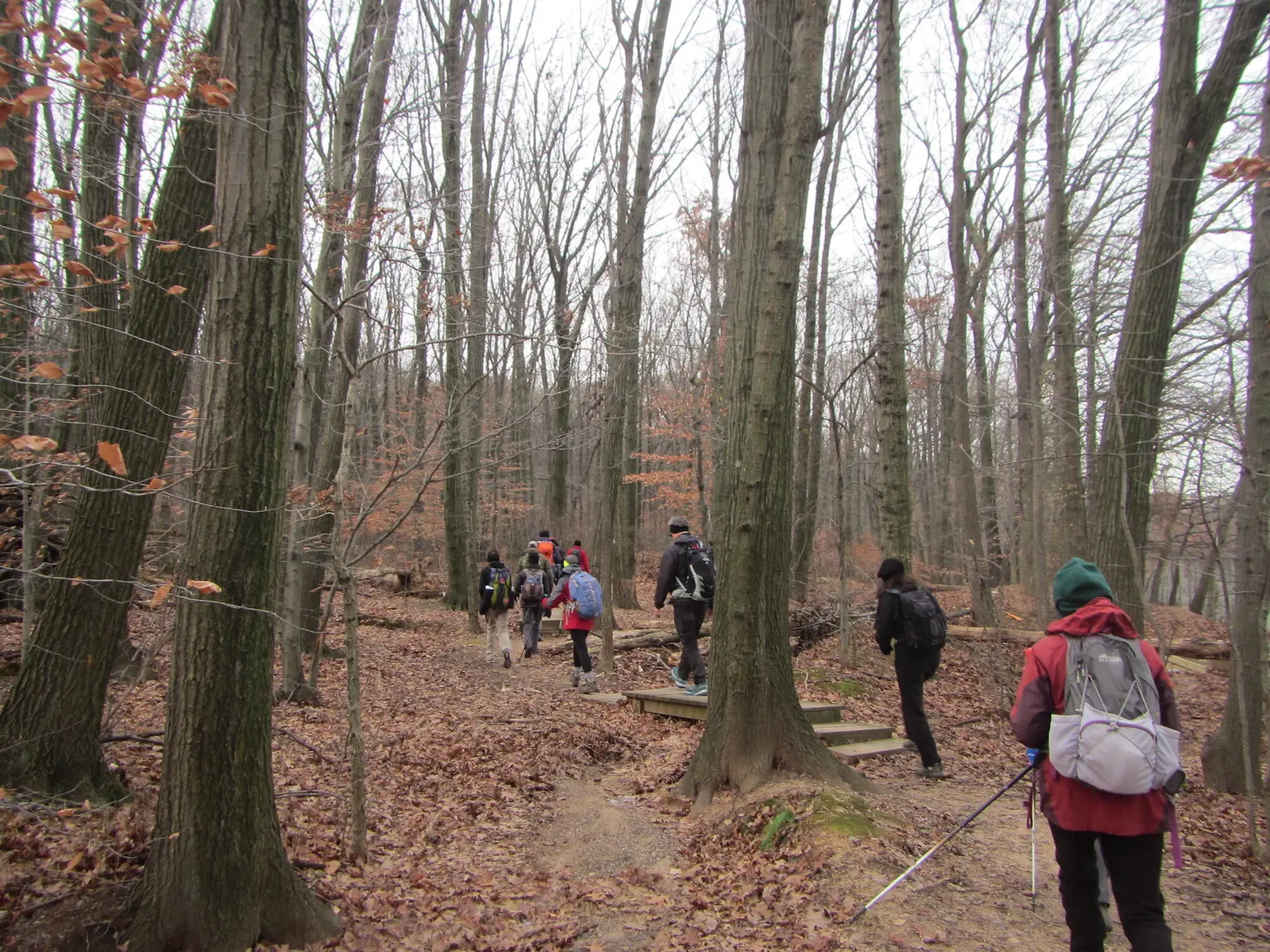
Photo of the Greenbelt by TheTurducken on Flickr
Staten Island
Staten Island Greenbelt
New York City’s greenest borough offers plenty of opportunities to connect with nature, particularly at the Staten Island Greenbelt, 3,000 acres of land located in the heart of the borough. The diverse habitats, from woodlands and swamps to ponds and lakes, provide multiple bird-watching spots within the massive protected parkland. The wooded High Rock Park contains five ponds and other wetlands, which attract wood ducks, great blue herons, hawks, owls, woodpeckers, and some migrating warblers. Other publicly accessible spots to explore within the greenbelt include Willowbrook Park, Latourette Park, Moravian Cemetery, the William T. Davis Wildlife Refuge, and Brookfield Park, according to NYC Audubon.
Clove Lakes Park
Measuring 193 acres, Clove Lakes Park is known for its natural landscape. It features multiple lakes, ponds, and a 300-year-old, 119-foot-tall tulip tree. On spring mornings in the park, visitors can see about 15 to 20 warbler species and scarlet and summer tanagers, and gray-cheeked thrush, according to NYC Audubon. Visitors should enter the park at Martling Avenue and follow the trail east to see feathered friends like hawks, woodpeckers, and white-breasted nuthatches. You’ll see ducks and geese during the fall and spring migration, wading birds in the summer, and more waterfowl, raptors, and warblers during the winter months, as NYC Audubon reports.
Great Kills Park
This 523-acre park is part of the Gateway National Recreation Area. Woods, marshlands, dunes, and beaches make up Great Kills Park, which runs about two miles along the South Shore of Staten Island. A diverse collection of birds visit the park, with about 279 species recorded on eBird. Uncommon spottings have included the parasitic jaeger, king elder, sandhill crane, and short-eared owl, to name a few. Located at the southern tip of the park, Crooke’s Point not only offers lovely views of the Lower New York Bay, but also provides a number of birding opportunities throughout the year, with warblers, vireos, orioles, and flycatchers seen during the late summer and early fall. In winter, purple sandpipers and ruddy turnstones visit Crooke’s Point and the jetty closer to Oakwood Beach.
Editor’s note: The original version of this story was published on April 5, 2021, and has since been updated.
